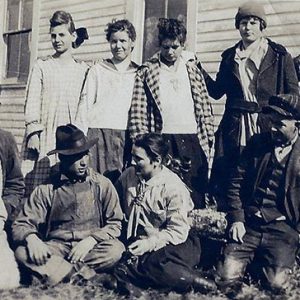calsfoundation@cals.org
Elmo (Independence County)
Elmo is a historic community located in a wooded area, with plowed fields on each side, between Highway 14 (Newport Road) and the White River, which is about a half mile away. Elmo is about four miles east of Oil Trough (Independence County) and about six miles west of Newport (Jackson County). Nearby are Dunnington (Independence County), Aydelott (Independence County), and Macks (Jackson County).
The White River bottoms in what became known as Pleasant Island and later Oil Trough first became a popular area for bear hunting by the French before the Louisiana Purchase of 1803. The rich alluvial soil beckoned farmers, who began growing cotton and corn in the early days of American settlement, even though the area was subject to frequent floods. The corn was sometimes used to make moonshine, which proved almost as profitable as bear oil.
A majority in the Oil Trough bottoms favored the Confederacy, and there were clashes between Union and Confederate troops in the area; nearby Batesville (Independence County) was twice occupied by the Union army during the Civil War. The Skirmish at Oil Trough Bottom on March 25, 1864, involved the hot pursuit of Confederate captain George Rutherford by the occupation Union army, chasing him out of Sulphur Rock (Independence County) across Magness Landing on the White River. A Union detachment of Captain Albert A. Irvin caught up with him near Oil Trough. In a surprise attack, the Confederates were routed, with four killed, one wounded, and two captured.
Elmo, located in the Oil Trough bottoms, was part of Colonel Virgil Young Cook’s extensive land holdings. In 1884, Cook’s holdings had become so large—about 8,000 acres in Jackson, Independence, Clay, and Greene counties—that he moved to his farmlands in Elmo from Olyphant (Jackson County) to better manage and oversee his property. Here, Cook lived on “Midland Holm,” a plantation of 5,000 acres. Besides being a landowner and Confederate veteran, Cook was a merchant, ginner, Olyphant’s first postmaster, and railroad agent for the Cairo and Fulton Railroad, and later a colonel during the Spanish-American War.
The Cook plantation house was built in 1875 about half a mile toward Oil Trough from where the post office later sat at Elmo. The lumber used in construction came from Cornerstone in Pleasant Plains (Independence County). The plantation building still stands but has been renovated, remodeled, and repaired several times since Cook moved. Local legend has it that the house is haunted by Cook’s ghost, which appears dressed in his Confederate uniform.
A post office was established at Elmo in 1879. The post office had a general store with it. Jefferson Davis (Jeff) Mack was appointed postmaster in 1938, and in March 1939 the post office was moved to Macks, with Jeff Mack transferred to the Mack store there. The name Elmo appears to be derived from the name of a local farm family; it may have been Elms with the “s” smudged on the application and mistaken by the U.S. Postal Service as an “o.” Another story maintains that Elmo was the last name of one of Cook’s railroad associates.
Other farm families in Elmo when the post office was established were the Simmons, Hinkle, Long, Runyan, Leonard, Roberts, Watson, Con, Chastain, Alumbaugh, Mantooth, and Hines families. Many settled in Elmo and the surrounding area from Tennessee following the Civil War; most had been pro-Confederacy, but a few—such as the Hines family—had supported the Union. Besides the lure of rich river bottomland for growing cotton, the Iron Mountain Railroad wanted people to settle along its railway corridor through Arkansas. The railroad put out posters encouraging people to migrate, offering land as an inducement to resettle.
By 1895, Elmo had a population of forty people, who were farming in the Oil Trough Bottoms on land owned by Cook. It had a store containing a post office, a church used by both Baptists and Methodists, two cotton gins, and Cook’s plantation house. After Cook moved to Batesville, the three Mack brothers—Jeff, Leonidas, and Sidney—built a cotton gin in 1909 at what came to be called Macks near Surrounded Hill and became major farmers of the region.
The medical needs of the Elmo community were provided for many years by Dr. Simeon David (Sim) Bateman, whose two-story residence was near Surrounded Hill, two miles east of Elmo, just across the line in Jackson County. Bateman died in 1914 and is buried in Surrounded Hill at Macks, the main cemetery used by those who lived in Elmo.
A school was opened in Elmo in the early 1900s for grades 1–8. The school later served students living in Macks. In 1947, Elmo and nearby Hulsey Bend merged with Oil Trough public schools. The few farmers left in Elmo began moving away, and all that remains at Elmo are one residence and a church, both on Highway 14.
For additional information:
Biographical and Historical Memoirs of Northeast Arkansas. Chicago: Goodspeed Publishing Co., 1889.
Matthews, Linda. “Cook-Morrow House.” Independence County Chronicle 55 (July 2014): 2–18.
McGinnis, A. C. “Farming in Oil Trough, 1904–1960.” Independence County Chronicle 13 (July 1972): 27–39.
———. “A History of Independence County, Ark.” Special issue. Independence County Chronicle 17 (April 1976).
Mobley, Freeman. Making Sense of the Civil War in Batesville-Jacksonport and Northeast Arkansas, 1861–1874. Batesville, AR: P. D. Printing, 2005.
Kenneth Rorie
Van Buren, Arkansas
 Sim Bateman
Sim Bateman  Elmo School
Elmo School  Independence County Map
Independence County Map  Midland Holm
Midland Holm 



Comments
No comments on this entry yet.